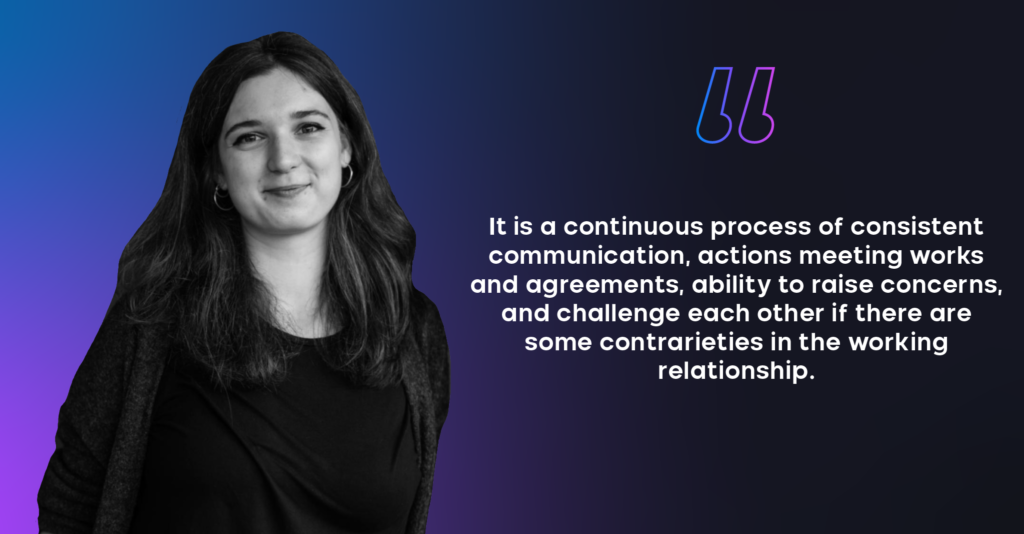Rugilė has transitioned her knowledge about organizational psychology and has been serving as a team lead for over five years, with three of those years spent at TeleSoftas. Throughout those years, she has consistently maintained a keen interest in performance talks. In the last three years, she has not only facilitated her team’s yearly performance talks but also trained others on how to effectively prepare for these discussions. Well, simply said – it is the discussion between an employee and their manager about employees’ work output and a look forward to future path and growth. It is important to understand, that performance conversations are a crucial part of our work, because not only do they help employees to reach their full potential, but also help to strengthen their work relationships and loyalty by sharing feedback to their managers, insights about the company and expectations for the future.
What is the performance talk?
We could say, that during performance talks there are two main parts of the meeting:
- Performance evaluation & goals have been reached,
- Development evaluation & goals for the future.
While looking back and talking about the performance, usually the manager discusses with an employee their work results, KPIs, and other metrics. Also, feedback that should’ve been gathered before.
So, during this part conversation goes mainly about how an employee is performing on their direct responsibilities.
As the conversation moves to the development part, an employee discuss their personal and professional growth with their manager. Usually, this discussion happens about lessons learned, growth wishes, and opportunities for the future. And we should not forget that this discussion – is two-way talking, where we can share feedback, wishes, and expectations and bring the reality check with each other (and the organization).

Why it is useful for managers and employees?
As the conversation moves to the development part, an employee discusses their personal and professional growth with their manager. Usually, this discussion happens about lessons learned, growth wishes, and opportunities for the future. And we should not forget that this discussion – is two-way talking, where we can share feedback, wishes, and expectations and bring the reality check with each other (and the organization).
How to prepare for the performance talk?
How to Steer Clear of Typical Errors in Performance Reviews
As it was discussed before, the performance review is the time of calibration with our employees. During this discussion, we reflect on the progress that was made, talk about growth & plans for the future, share & discuss the feedback (for both sides), and align the expectations towards each other, the team, the company, and other stakeholders.
And yet, we as managers, can prepare for the meeting as much, as we can, and still face complicated situations during this discussion. The complexity of those kinds of situations arises because we are not expecting them or we are not dealing with them quite often. For example, unexpected need to deal with strong emotional reactions, blaming others, or not having time for meetings with you or avoiding those. As you might already understand, while preparing for performance discussion, consciously or unconsciously we are preparing for those situations also.
Complicated situations & going through them:
Adapting and reacting
As you can see – there might be different kinds of complicated situations, and the list is non-finite. Sometimes life happens and we are forced to adapt our plans and reaction to reality. At the same time, you can see -healthy curiosity, mutual trust, respect, openness, knowing what we want from our employees (role, responsibilities, development, etc.), and understanding your role and accountabilities can help you a lot, even if you’re not prepared for some spicy situations.
Communication in the working relationship
As you possibly, already understood – a performance review could be understood as a broader thing, than a once-a-year meeting. This is a continuous process of consistent communication, actions meeting words and agreements, an ability to raise concerns, and challenge each other if there are some contrarieties in the working relationship. That’s why it is important to work on mutual trust, healthy and constructive conflict resolution, and mutual accountability if we want to have fruitful and honest performance discussions for both parties. And of course, active listening skills, feedback-sharing skills, an ability to listen and consider it – are universal skills, which help a lot in various situations, where we need to understand each other. So, prepare and plan your performance discussions not only by having a structure for the meeting but also by actively working on it throughout the year.

Rugilė Žickytė
This article was written by a Learning & Development Lead in TeleSoftas. For more insights, follow her on Linkedin – Rugilė Žickytė.
